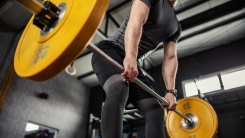How to Add Up the Weights When You’re Lifting With a Barbell

Pop quiz: You want to lift 185 pounds. How many plates do you put on each side of the barbell, and what sizes? If you didn’t immediately answer “a 45 and a 25, of course,” perhaps a little primer on plate math would help.
Yes, you count the bar
Let’s start with the basics. When you tell somebody how much weight you lifted, that weight includes the total poundage that you had in your hands. The bar is part of that.
At most gyms in the U.S., a typical barbell is seven feet long and weighs either 45 pounds, or 20 kilograms (which works out to 44 pounds). If the rest of your weight plates are in pounds, go ahead and assume it’s 45.
If your gym has multiple sizes of bar, check the end for a label giving the weight, or ask somebody. If your gym has kilo plates, or if it’s a Crossfit box, you should know that Olympic style weightlifting is done with a 20 kilogram bar for men (close enough to 45 pounds), and a shorter, narrower 15 kilogram bar for women—which Crossfitters tend to estimate as 35 pounds, even though between you and me it’s closer to 33. (Why do women’s barbells exist in the first place? There’s a whole story to that, which I explain here.)

$117.89
at Amazon

Your gym might also have lighter bars, which could be 25 pounds or even 10. Home exercise equipment sometimes uses a 1-inch-wide bar without the wider collars you’ll see on Olympic or powerlifting bars; those bars are lighter, and you should weigh yours or check the package to see what you’ve got.
If you’re lifting with a Smith machine, or any other kind of machine, don’t bother trying to figure out how much the machine or its bar weighs. Every machine is different, they’re almost never labeled, and the weights won’t necessarily feel the same as they would on a barbell. Just write down the total weight you loaded onto it—that’s enough for record keeping purposes.
What about the clips or collars that hold the weight on? Usually they’re not heavy enough to bother adding into your calculations, but if they’re large and you know the weight, feel free to include them.
Here’s the formula to know how much weight is on the bar
This may be obvious, but I want to make sure this information is easy to find: to find the total weight you’ve put on the bar, add up the plates on one end, double that number, and add the weight of the bar.
So if you have a 45 and a 25 on each end, add 25 + 45 to get 70, double that (140), and add the weight of the bar (140 + 45 = 185).
More often, though, you start with a number you’d like to lift, and then have to load the bar appropriately. Start practicing and soon you’ll be able to load a bar correctly without thinking about it too much. Here’s how:
Memorize common weights in pounds
Let’s assume we’re working with a 45 pound bar. You’ll end up using the same combinations over and over, and these numbers will start to look really familiar:
-
55 pounds: a 5-pound plate on each side
-
65 pounds: a 10-pound plate on each side
-
95 pounds: a 25-pound plate on each side
-
135 pounds: a 45-pound plate on each side
-
225 pounds: two 45-pound plates on each side
-
315 pounds: three 45-pound plates on each side
-
405 pounds: four 45-pound plates on each side
-
495 pounds: five 45-pound plates on each side
As you warm up for a lift, you can do the math as you put plates on. Say you do a set with just the empty bar, then with a 10 on each side (that’s 65), then a second pair of 10s (85), then swap both of those out for a 25 (now we’re up to 95) and you want to do your next set at 100. You know you need five more pounds, so look for a pair of 2.5 pound plates and there you go.

$339.99
Memorize common weights in kilograms
Some gyms have their plates in kilos instead of pounds. (Some have both, so keep your wits about you!) The principles are the same: count the bar, and memorize common combinations. Bumper plates and competition-style steel plates are often color-coded, so I’ve included the colors below:
On a 15kg women’s bar:
-
A pair of 10 kilo plates (green) = 35kg
-
A pair of 15s (yellow) = 45kg
-
A pair of 20s (blue) = 55kg
-
A pair of 25s (red) = 65kg
-
Two pairs of 25s = 115kg
-
Three pairs of 25s = 165kg
Or, if you’re using a 20kg men’s bar:
-
A pair of 10 kilo plates (green) = 40kg
-
A pair of 15s (yellow) = 50kg
-
A pair of 20s (blue) = 60kg
-
A pair of 25s (red) = 70kg
-
Two pairs of 25s = 120kg
-
Three pairs of 25s = 170kg

$86.97
If you go back and forth between pounds and kilos, it helps to be able to convert them in your head. Multiply kilos by 2.2 to get pounds, or divide pounds by 2.2 to get kilos. (Kilos are “bigger” than pounds, so the same object will weigh a smaller number of kilos and a larger number of pounds.) Some of the numbers are nicely symmetrical:
-
5kg = 11 pounds
-
10kg = 22 pounds
-
20kg = 44 pounds
-
30kg = 66 pounds
-
40kg = 88 pounds
-
50kg = 110 pounds
-
100kg = 220 pounds
-
150kg = 330 pounds
I lift at one gym where everything is in kilos, and another where everything is in pounds. Fortunately, I do different lifts in each place, so I just keep my Olympic lifting notes in kilos and my powerlifting notes in pounds. I recommend this approach rather than trying to convert units on every lift as you do it.
If you’re not used to working in kilos, start with memorizing just one number: your own bodyweight in kilos. That lets you make quick judgments like “This is heavier than me” or “This is about half my weight” without having to whip out a calculator.
Apps and calculators help
Yes, there are calculators that will do the job for you. I track my workouts in an app called Strong, and it has a little button that will tell you how to load the bar for your lift. RackMath (free on iOS and Android) looks like a good option for a standalone app.
An online equivalent is this calculator from ExRx. Note that you have to tell any calculator how heavy your bar is, what sizes of plate you have available, and how many of each there are. In a gym the plates may be unlimited, but in a home gym there may be certain numbers you just can’t achieve because you don’t have the right combination of plates.



